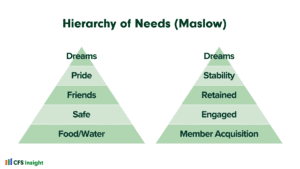Many credit unions are currently experiencing pressure to reduce or outright eliminate many of their fees. Some of the largest banks in the world, representing trillions of dollars in transactions, have already made the switch. Even a partial list can be daunting. Wells Fargo earned 1.4b in overdraft fees in 2021 alone. Even ignoring these factors, members can see many of these fees as opaque and unfair.
But many CUs operate with thin margins. Even if the CU is aligned with removing some or all of its fees, it still creates a financial squeeze. This revenue needs to be replaced somewhere.
There are a few options (most notably, using CFS’s Member Revenue Model), but many come with complications, as we will see.
Increase Other Fees
Some CUs will simply increase the amount they charge in other places to compensate for some of their ODP fees. Many CUs find this difficult to implement for a couple of different reasons.
- Raising the non-ODP fees to the level that would replace that revenue is difficult.
- In an era of reducing fees and competition for shares, it is difficult to justify this increase.
Loans
Some CUs will look to increase their lending to offset the revenue loss. This also comes with some challenges. Higher interest rates have already cooled the lending market. Lending also comes with regulatory overhead, liquidity concerns, charge-off reserve, and sometimes additional staff. So, while the CU may generate additional revenue, it comes at a much higher cost.
Interchange
If neither raising non-ODP fees or loans are a viable option, what can the CU do? If you look at all the revenue sources for the CU, the best in terms of value and risk is interchange income. It is essentially revenue from the member using their existing share account with a debit card. It doesn’t require any additional investment and carries almost no risk. So why don’t more CUs look to this option?
One issue is that many CUs only see a lump sum payment for their monthly interchange income. It differs from loan revenue, where you can see you received so much in interest and late payments, and you know how much each member contributed in a specific period. Not being able to see which members are generating interchange and by how much is a blind spot for the CU.
This is a solvable problem, and it doesn’t require supercomputers or a Ph.D. in statistics. The CU can use something as simple as a linear regression to estimate the value of the interchange income. Some CUs can be convinced that they are only really doing analytics if they are using the newest and most powerful machine learning algorithms.
Here is a sample from a customer we recently worked with. Below is a year’s worth of interchange income with both the actual for that period and what the model predicted.
| Period | Actual | Predicted |
| 1 | $ 360,858.34 | $ 405,661.54 |
| 2 | $ 419,053.62 | $ 403,371.40 |
| 3 | $ 421,032.01 | $ 415,726.67 |
| 4 | $ 414,818.53 | $ 398,383.68 |
| 5 | $ 397,022.64 | $ 395,877.55 |
| 6 | $ 432,750.76 | $ 417,264.70 |
| 7 | $ 381,879.91 | $ 375,195.47 |
| 8 | $ 411,015.14 | $ 414,418.31 |
| 9 | $ 410,568.22 | $ 399,068.63 |
| 10 | $ 393,898.51 | $ 425,108.86 |
| 11 | $ 412,304.90 | $ 391,722.39 |
| 12 | $ 384,168.40 | $ 381,101.42 |
| Total | $ 4,839,370.98 | $ 4,822,900.64 |
The total error for this model is $16,470.34, which, when viewed as a percentage, is 0.34%. While you have some periods that are a little up and some that are a little down, this model is as accurate as what the CU needs to make good decisions.
Learn More About Our Solutions
Creating the Desired Outcome
As you can see, this simple model effectively created the desired outcome. This data, tied with the rest of the loan and fee income, now gives the CU a complete picture of the revenue at a member level. Once you have the revenue model in place, you can extend it with cost and get net income for a member and, by extension, various combinations of members grouped by age, branch, product combination, length of membership, etc.
With the interchange income in hand, the CU can create campaigns to target specific member groups to increase their interchange income. This is a much easier ask for many members since you are not asking them to sign up for another loan or do something they are not doing today. You are only nudging their behavior in a smaller way. This will increase your revenue without the downsides of adding fees or loans. You can see more information about our member revenue model here.




